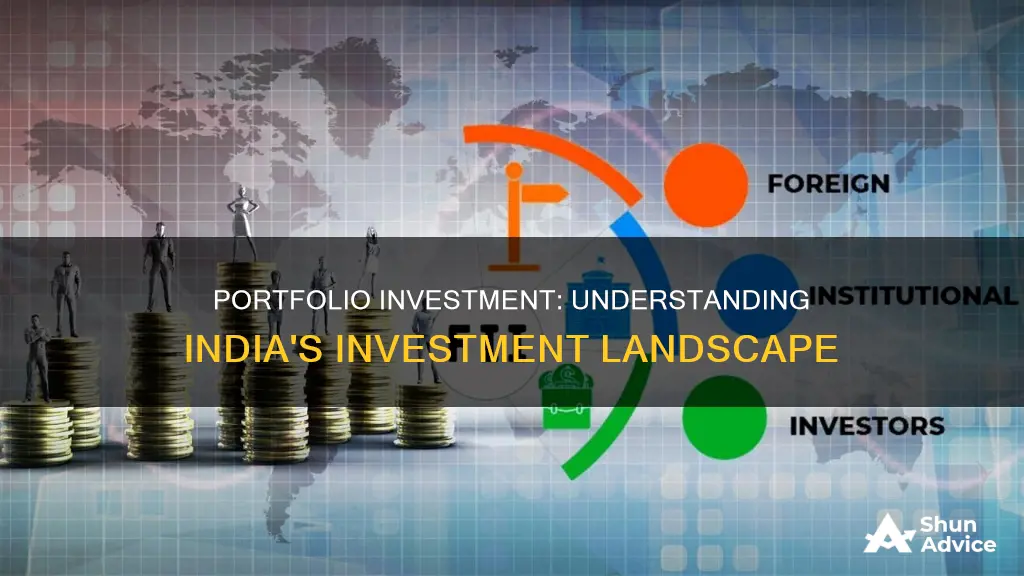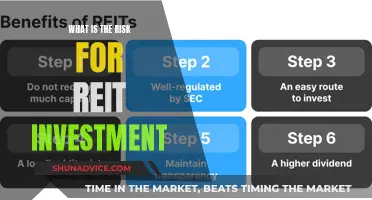
A portfolio is a collection of financial investments, such as stocks, bonds, commodities, cash, and cash equivalents, including closed-end funds and exchange-traded funds (ETFs). Portfolio investment involves buying financial assets with the expectation of earning returns. A portfolio investment may be either strategic, where investors buy financial assets intending to hold them for a long time, or tactical, where they actively buy and sell assets to achieve short-term gains. Foreign portfolio investment (FPI) is a common way for investors to participate in an overseas economy, especially for retail investors. FPIs allow investors to acquire financial assets, such as stocks and bonds, in another country to diversify their portfolios. India has attracted significant FPI in recent years, reflecting investors' confidence in its growth prospects and the government's proactive policies.
| Characteristics | Values |
|---|---|
| Definition | A portfolio is a collection of financial investments. |
| Types of assets | Stocks, bonds, commodities, cash, cash equivalents, real estate, gold, paintings, and other art collectibles. |
| Management | Individuals may manage their own portfolios or seek the assistance of professional financial advisors. |
| Diversification | Diversification is a key concept in portfolio management. |
| Risk | A person's tolerance for risk is a critical factor when assembling and adjusting an investment portfolio. |
| Investment objectives | Investment portfolios are assembled with specific financial goals in mind. |
| Time horizon | The time horizon influences the types of assets and investment strategies chosen for the portfolio. |
What You'll Learn

Foreign portfolio investment (FPI)
In the context of India, FPI is an important source of investment, with the country attracting significant FPI inflows due to its stable economy, growth prospects, and favourable regulatory environment. FPI in India is regulated by the Securities and Exchange Board of India (SEBI) and includes investment groups, foreign institutional investors (FIIs), and qualified foreign investors (QFIs).
FPIs offer several benefits, including international diversification for investors, enhanced liquidity, and the potential for higher returns. However, they also carry risks, such as currency fluctuations, political instability, and economic volatility in the foreign market.
Compared to Foreign Direct Investment (FDI), FPIs are generally smaller in size, shorter in duration, and do not involve the transfer of intellectual property, technology, or direct management control. While FDI involves establishing a tangible business interest in the target country, FPIs are passive investments in financial assets that offer quicker returns and easier exit options.
FPIs play a crucial role in global diversification, providing investors with access to international markets and enhancing their potential for higher returns. By investing in FPIs, investors can spread their risk across multiple countries and tap into diverse economic growth opportunities worldwide.
Smart Ways to Invest Your RBFCU Savings
You may want to see also

Diversification
There are several ways to diversify a portfolio:
- Distributing investments across a wide range of vehicles: This includes investing in a variety of assets such as cash, stocks, bonds, mutual funds, ETFs, and other financial instruments. By investing in assets with low historical correlations, investors can ensure that even if one part of their portfolio performs poorly, other parts may still grow.
- Maintaining diversity within each asset category: For stocks, this means investing in securities from different sectors, industries, geographic regions, and market capitalizations. For bonds, this means varying maturities and credit qualities. This approach helps to reduce the impact of any single factor on the performance of the portfolio.
- Investing in securities with different risk profiles: Including a mix of low-risk and high-risk investments in a portfolio can help balance it. This strategy allows for the possibility that significant gains in high-risk areas may offset losses in more stable, low-risk investments.
The right mix of assets in a portfolio depends on the investor's risk tolerance, financial goals, and timeline. Conservative investors, for example, tend to prefer a higher proportion of bonds and cash equivalents, while aggressive investors are more likely to invest in high-risk, high-return assets. Additionally, investors nearing retirement are usually advised to shift their portfolios towards less risky assets, while those at the beginning of their careers may opt for riskier investments.
Investing Life Savings: Strategies for Long-Term Financial Growth
You may want to see also

Risk tolerance
Conservative investors, for instance, tend to be more averse to risk and prefer investments that preserve their capital and provide a steady income. Their portfolios typically include large-cap value stocks, investment-grade bonds, cash equivalents, and market index funds. These investments are generally considered lower-risk options and offer more stable returns.
On the other hand, individuals with a high-risk appetite are willing to take on more risk in pursuit of higher returns. Their portfolios may include small-cap and large-cap growth stocks, high-yield bonds, gold, oil, real estate, and other alternative investments. These investments carry a higher degree of risk but also offer the potential for substantial gains.
It is important to note that risk tolerance can change over time due to various factors such as age, financial situation, and market conditions. As investors approach retirement, for example, they may shift their portfolios towards more conservative investments to protect their accumulated earnings. Conversely, younger investors with a longer time horizon may be more comfortable investing a larger portion of their portfolio in riskier assets, as they have more time to recover from potential losses.
Additionally, risk tolerance plays a crucial role in determining the investment allocation style of a portfolio. Conservative investors typically opt for a more cautious approach, favouring investments that preserve their capital. Moderate investors aim for a balance between risk and return, investing in a diverse range of assets. Growth-oriented investors focus on capital appreciation and allocate a larger share of their portfolio to stocks. Aggressive investors have a high-risk tolerance and are comfortable with volatile investments, maximising their exposure to stocks and other high-risk assets.
In conclusion, understanding one's risk tolerance is essential for building a successful investment portfolio. It helps investors make informed decisions about the types of assets to include in their portfolio, the level of risk they are comfortable with, and how to adjust their portfolio over time to align with their financial goals and changing circumstances.
Understanding Passive Portfolio Investment Vehicles: Strategies and Benefits
You may want to see also

Active vs passive management
A portfolio is a collection of financial investments like stocks, bonds, commodities, cash, and cash equivalents, including closed-end funds and exchange-traded funds (ETFs). Portfolio management involves selecting and overseeing a group of investments that meet a client's long-term financial objectives and risk tolerance.
There are two main investment strategies that can be used to generate a return on investment accounts: active portfolio management and passive portfolio management. Active portfolio management involves more frequent trades than passive management. It focuses on outperforming the market compared to a specific benchmark, such as the Standard & Poor's 500 Index. The performance can be measured using Active Share and by comparing portfolio holdings to the benchmark. Active management requires a team of experts who can forecast and suggest possible actions that may benefit the investors. It is beneficial for fluctuating markets and requires a good understanding of the market. However, it comes with a higher cost due to the frequent buying and selling of securities.
Passive portfolio management, on the other hand, mimics the investment holdings of a particular index to achieve similar results. It is also known as index fund management and is designed to parallel the returns of a particular market index or benchmark. A passive strategy does not have a management team making investment decisions and can be structured as an exchange-traded fund (ETF), a mutual fund, or a unit investment trust (UIT). Passive management has lower management fees and is considered a relatively safe approach to investing in broad segments of the market. However, the returns are restricted and will never exceed those of the underlying index being tracked.
Both active and passive management have their advantages and disadvantages. Active management offers the potential for higher returns but comes with greater risks and larger fees. It is suitable for those willing to take on more risk. On the other hand, passive management has lower costs but restricted returns. It is a good option for those who are risk-averse. Investors should assess their risk tolerance and requirements before choosing a management strategy.
How to Make Your Savings Work for You
You may want to see also

Investment allocation styles
Conservative investors prefer to preserve their savings, capital, and income and typically have a higher proportion of bonds and cash equivalents. They opt for investments with lower risk factors, such as government bonds and blue-chip stocks.
Some investors opt for income-focused allocations for regular cash flow from dividends and interest payments. These investors may choose dividend-paying stocks or other types of distributions to stakeholders, such as real estate investment trusts (REITs).
Moderate allocations aim to balance risk and return with a more even mix of stocks and bonds. This approach is suitable for investors who want to balance their portfolios with investments that perform differently under various economic conditions.
Growth-oriented allocations emphasise capital appreciation, with a larger share of stocks to potentially achieve higher long-term returns. These portfolios are subject to greater risks but offer high-risk and reward aspects.
Aggressive allocations maximise exposure to stocks and higher-risk assets, suitable for those with a high-risk tolerance and longer investment horizons. These investors seek out companies in their early growth stages with a unique value proposition.
Investment Portfolio: Where to Find and How to Start
You may want to see also
Frequently asked questions
A portfolio is a collection of financial investments like stocks, bonds, commodities, cash, and cash equivalents, including closed-end funds and exchange-traded funds (ETFs).
FPI involves investors acquiring financial assets, such as stocks and bonds, in another country to diversify their portfolios. FDI lets an investor purchase a direct business interest in a foreign country.
Common asset classes for portfolio investment include stocks, bonds, cash equivalents, real estate, commodities, and alternative investments like cryptocurrencies, private equity, or hedge funds.
Investors' risk appetite, time-frame of investment, and financial goals are some of the factors that tend to influence portfolio allocation.







